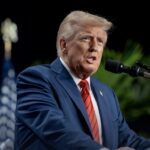As Indian trade negotiators commenced what could be their final in-person talks in Washington, D.C. on June 27, 2025, a looming July 9 deadline casts a long shadow over the future of U.S.-India trade relations.
While President Donald Trump optimistically hinted at a “very big” deal that would “open up India,” the underlying complexities and geopolitical currents suggest the stakes extend far beyond immediate tariff concessions. The outcome of these high-pressure negotiations will not only redefine bilateral economic ties but could also signal the direction of India’s trade policy and the durability of the U.S.’s transactional approach to international commerce.
The July 9 deadline marks the end of President Trump’s 90-day suspension of the “Liberation Day” country-specific tariffs, originally imposed on April 2. Failure to reach an agreement could theoretically lead to their re-imposition, though trade experts deem this unlikely, given that the U.S. has only secured a “mini-deal” with the UK from a list of 57 targeted countries.
Nevertheless, the ticking clock undoubtedly builds pressure on India to concede to U.S. demands to avoid any renewed tariff uncertainty.
Sources close to the negotiations indicate that little progress was made in previous rounds, with market access in agriculture and other sensitive areas remaining significant sticking points. This final push is a test of both nations’ resolve and their ability to navigate domestic political sensitivities against the backdrop of broader strategic alignment.
Two Paths Diverge: Mini-Deal vs. Red Lines
The current negotiations appear to be charting two distinct paths.
Option One: The “Mini-Deal” Scenario. This outcome, perhaps styled after the U.S.-UK limited trade pact, seems more probable. Under such a deal, India is expected to offer MFN tariff cuts on a range of industrial goods, notably automobiles, a persistent demand from Washington. Limited market access through tariff reductions and tariff-rate quotas (TRQs) on select U.S. agricultural products like ethanol, almonds, and apples are also on the table.
Beyond tariffs, Washington is poised to push for large-scale commercial purchases – including oil, LNG, Boeing aircraft, helicopters, and potentially nuclear reactors. Pressure on India to ease FDI restrictions in multi-brand retail (benefiting giants like Amazon and Walmart) and liberalize rules on remanufactured goods is also anticipated.
In return, the U.S. would likely refrain from reimposing the controversial 26 percent country-specific tariffs. However, a critical analytical point emerges here: the U.S. is not expected to lower its own MFN tariffs on Indian exports. This implies a non-reciprocal arrangement where Indian goods would continue to face higher tariffs (MFN+10 percent) in the U.S., while U.S. exports enjoy reduced or zero duties in India. This lack of full reciprocity raises questions about the long-term equity of such a “mini-deal” and its potential for fostering a truly balanced trade relationship. Importantly, a mini-deal would punt on broader Free Trade Agreement (FTA) issues like services trade, intellectual property rights, and digital regulations, leaving them for future, more comprehensive negotiations.
Option Two: No Deal – Holding the Line. The alternative is a collapse of talks if the U.S. continues to insist on opening India’s core agricultural sectors, particularly dairy, or allowing entry of genetically modified (GMO) products. India has unequivocally stated that it cannot compromise on staple crops and dairy, citing the livelihoods of over 700 million people in its rural economy and paramount national food security concerns.
While agricultural goods constitute less than 5 percent of U.S. exports to India, Washington’s persistent push suggests a strategic objective beyond sheer volume – potentially aiming to influence India’s domestic agricultural policies, such as minimum support prices (MSP) and public procurement systems, which are foundational pillars of India’s food policy. Should no deal materialize, trade experts believe the reimposition of the 26 percent tariffs is unlikely, but the unpredictable nature of U.S. trade policy under the current administration means surprises cannot be ruled out.
India’s Strategic Balancing Act
India’s negotiation stance reflects a complex balancing act between economic growth, strategic interests, and domestic political realities. The NITI Aayog’s suggestion of concessions on “soybean oil imports” highlights India’s pragmatism in addressing the trade imbalance while safeguarding domestic production. Furthermore, India’s pivot towards increasing oil and defense procurement from the U.S., evidenced by a surge in crude oil imports to $63 billion in March 2025, underscores a broader strategic alignment aimed at diversifying its energy and security partnerships. This move could also significantly help bridge the goods trade gap.
However, India’s insistence on duty concessions for its labor-intensive sectors (textiles, gems and jewelry, leather goods) reveals its core priority of leveraging trade to boost employment and exports in key manufacturing and traditional industries.
U.S. Limitations and Geopolitical Context
A significant constraint for the U.S. in these negotiations is the current absence of a valid Trade Promotion Authority (TPA). Without TPA, the current administration’s legal capacity to reduce tariffs is severely limited. This means any tariff-related discussions may be confined to executive-level tariffs, raising pertinent questions about the long-term durability and comprehensive nature of any deal reached. This limitation inherently restricts the scope of the agreement, pushing it towards a “mini-deal” rather than a holistic FTA.
President Trump’s comparison of the India talks to the recently signed China deal is telling. It positions India within the broader context of the U.S.’s trade-rebalancing agenda, aiming to “open up” large economies to American goods and services. For India, engaging in a significant bilateral deal with the U.S. offers the potential for greater integration into global supply chains and a counterweight to other regional economic influences, particularly China.
The Larger Implications: Sovereignty and Future Trade Architecture
Ajay Srivastava of GTRI succinctly captures the overarching implication: “Any trade deal with the U.S. must not be politically driven or one-sided, it must protect our farmers, our digital ecosystem, and our sovereign regulatory space.” This statement encapsulates India’s deep-seated concerns about safeguarding its domestic economy and maintaining policy autonomy in critical sectors.
The negotiations are not merely about tariff lines; they are about the architecture of future global trade. Will this mini-deal set a precedent for future bilateral agreements that prioritize specific commercial gains over comprehensive, reciprocal liberalization? For India, a nation increasingly asserting its economic independence, the terms of this deal will be a litmus test of its ability to negotiate a balanced outcome that serves its national interests while navigating the complexities of great power trade dynamics.
The outcome, whether a limited pact or a temporary impasse, will undoubtedly shape the trajectory of U.S.-India relations and influence the broader contours of international trade in an increasingly multipolar world.


![india-us-trade[1].jpg](https://southasianherald.com/wp-content/uploads/2025/06/india-us-trade1.jpg-1170x661.jpeg)



